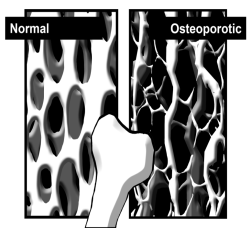World Osteoporosis Day October 20
You may not have been aware that October 20th is World Osteoporosis Day. What does this have to do with you? You might be one of the 10 million Americans who have osteoporosis or one of another 44 million individuals with low bone density. Both conditions increase the risk of a sustaining a broken bone in your lifetime.
You may be saying, “Not me, I feel fine.” That may be true because bone loss doesn’t cause pain or symptoms to alert you to the developing disease. Take a minute to learn more about osteoporosis because the first sign of the disease is a broken bone.

Who is susceptible to osteoporosis? Everyone loses bone strength or density with aging; so everyone has some risk. The amount of bone accumulated is completed by age 30. Like a retirement account, building bone needs to start early in order to offset the inevitable loss that accompanies the aging process. Certain lifestyle behaviors, diseases and medications can accelerate bone loss.
Screening for bone loss prior to a first fracture is ideal in order to determine a strategy to prevent bone loss and initiate treatment if indicated. Additionally, you can calculate your risk factors by using a tool called FRAX® which will calculate your personal health information and provide the 10-year probability of sustaining a fracture. Visit: www.sheffield.ac.uk/FRAX/. Discuss the need for a painless bone density test called a DEXA with your health care provider. The National Osteoporosis Foundation recommends that you have bone density testing if:
- you are a woman age 65 or older
- you are a man age 70 or older
- you break a bone after age 50
- you are a woman of menopausal age with risk factors
- you are a postmenopausal woman under age 65 with risk factors
- you are a man age 50-69 with risk factors
A bone density test may also be necessary if you have any of the following:
- an X-ray of your spine showing a break or bone loss in your spine
- back pain with a possible break in your spine
- height loss of ½ inch or more within one year
- total height loss of 1½ inches from your original height
www.nof.org/patients/diagnosis-information/bone-density-examtesting
World Osteoporosis Day (WOD), on October 20 each year, marks a year-long campaign dedicated to raising global awareness of the prevention, diagnosis and treatment of osteoporosis. If you haven’t evaluated your personal risk for osteoporosis, make October 20th a deadline for doing this.
The information and resources listed below can help you develop a personalized course of action to preserve bone and prevent fractures.
www.nof.org/patients/what-is-osteoporosis/
Sharon Baker is a commissioner on the Georgia Commission on Women.
